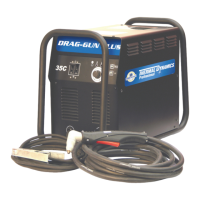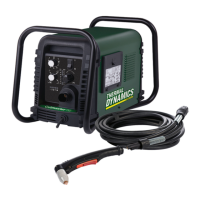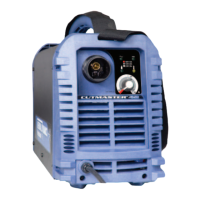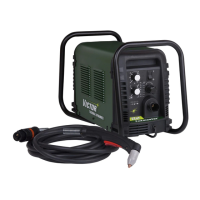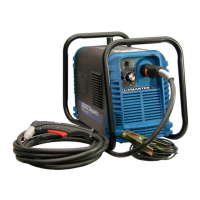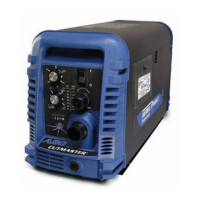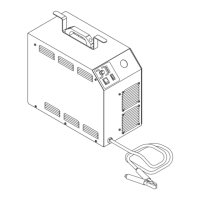Manual 0-2683 13 TROUBLE-SHOOTING
2. Damaged power cord.
a. Confirm with voltmeter if AC line voltage is
present at input to power switch.
If AC voltage is present, proceed to next step.
If ac line voltage is not present, replace Power
Cord.
3. Power Switch faulty.
a. Confirm with voltmeter if AC line voltage is
present at main Capacitor (C13) terminals when
power switch is on.
If AC line voltage is not present, replace Power
Switch.
D. Power OK, service circuit breaker or fuse opens
after the power switch is switched on.
NOTE
Proceed with troubleshooting for these components
in order:
1. Faulty Fan.
a. Disconnect the Fan and insulate the two wires
going to the Fan with tape (separately), then
reapply power.
If the circuit breaker or fuse opens after the
power switch is switched on, go to next step.
If the circuit breaker or fuse is okay, replace Fan.
2. Faulty Transformer Assembly or Capacitor.
a. With the Fan still disconnected, disconnect two
leads from the transformer that are connected
to the Capacitor (C13) , then apply power.
If the circuit breaker or fuse opens after power
is applied, the Capacitor is shorted. Replace
Capacitor (C13).
If the circuit breaker or fuse is okay, replace
Transformer.
E. Power OK, fan runs, no compressor operation or
pilot when torch switch pressed.
1. Shield cup loose, PIP not making contact.
a. Reseat the torch parts, tighten shield cup.
2. Unit overheated.
a. Leave power on so fan can cool unit, test again
after 10 minutes.
3. Shorted torch parts.
a. Replace torch consumables.
4. Torch switch may have broken or shorted wires.
a. Refer to subsection 3.6, Torch and Leads Trouble-
shooting.
5. Overheated or faulty Compressor.
a. Press the torch switch.If a clicking can be heard
and/or the Relay is actuating (test button on
side pulls in), the Compressor motor may have
failed or overheated. If the Case of the Com-
pressor motor feels very warm, allow it to cool
and try again. The Compressor has its own
overtemp cutout switch.
If the unit fails to operate once it has cooled
down, replace the compressor.
6. Shorted Bridge Rectifier (BR2)
a. If the Rectifier (upper) is hot and the Transformer
is buzzing or heating up, the rectifier is shorted.
Replace Rectifier.
7 . Faulty Control PCB or Relay
CAUTION
Be sure torch is directed away from people or haz-
ards. A pilot arc may start!
a. Push the test button on the side of the Relay. If
the Compressor starts and the torch operates,
the PCB or Relay has most likely failed.
The PCB can be isolated by removing the push
on connectors from the Relay coil and measur-
ing the relay coil with an ohmmeter. If the coil
measures between 50 - 100ohms, the Relay is
good and the PCB should be replaced.
If the Compressor runs intermittently and arc-
ing can be seen in the Relay case while the torch
switch is held on, the Relay contacts are worn
and the Relay should be replaced.
F. Power OK, fan runs, compressor runs intermit-
tently, Relay Case shows arcing when the torch
switch is held on.
1. Faulty Relay.
a. If the Compressor runs intermittently and arc-
ing can be seen in the Relay Case while the torch
switch is held on, the relay contacts are worn
and the Relay should be replaced.
